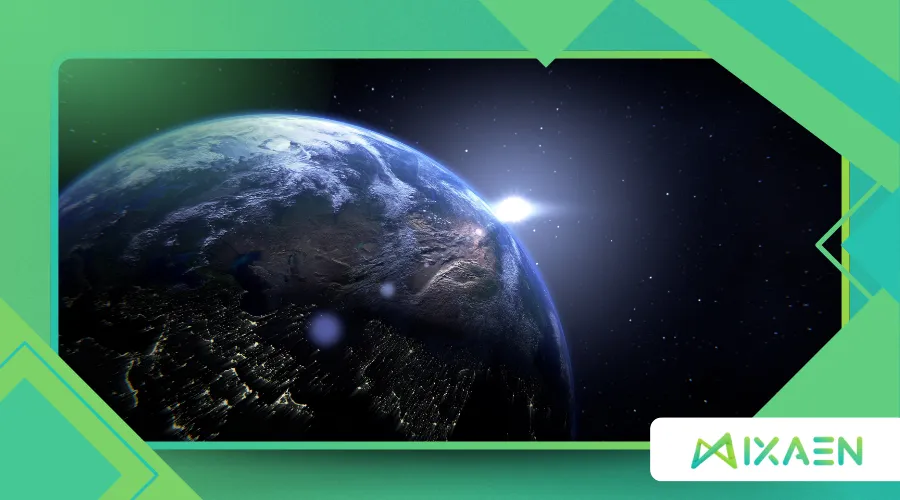How Planetary Rotation Shapes the Habitability of Exoplanets

Planetary rotation is a subtle yet profound force that shapes the potential for life on distant exoplanets.
Anúncios
It’s not just about a planet spinning on its axis; it’s about how that spin choreographs a delicate dance of climate, atmosphere, and energy distribution that could make or break a world’s habitability.
As astronomers peer deeper into the cosmos, uncovering thousands of exoplanets, the question of what makes a world livable grows ever more complex.
Rotation isn’t just a mechanical trait—it’s a cosmic conductor, orchestrating conditions that could nurture life or render a planet barren.
In this exploration, we’ll unravel how the rhythm of a planet’s spin influences its ability to sustain life, blending cutting-edge science with fresh perspectives.
The Cosmic Waltz of Day and Night
Imagine a planet where one side basks eternally in sunlight while the other languishes in perpetual darkness.
Such is the fate of tidally locked exoplanets, where planetary rotation synchronizes with their orbit, leaving one hemisphere scorched and the other frozen.
This extreme dichotomy challenges habitability by creating stark temperature gradients.
Life, as we know it, thrives in stable conditions, requiring liquid water and moderate climates.
A tidally locked world struggles to provide these, as the day side may boil away oceans while the night side traps water in ice.
Contrast this with Earth’s 24-hour rotation, which balances day and night, distributing solar energy evenly.
This cycle regulates temperatures, drives weather patterns, and fosters ecosystems.
For exoplanets, a similar spin could be a golden ticket to habitability, ensuring neither side of the planet becomes an uninhabitable extreme.
But what happens when rotation speeds vary wildly?
Could a planet spinning too fast or too slowly still harbor life?
This question pushes us to explore the intricate interplay of rotation and environmental stability.
Recent studies suggest that planets with varying rotation speeds can still maintain habitable conditions if other factors, such as atmospheric composition and distance from their star, are favorable.
Rotation’s Role in Atmospheric Dynamics
A planet’s spin doesn’t just dictate day length—it sculpts its atmosphere.
Rapid planetary rotation, like Jupiter’s 10-hour day, generates powerful atmospheric currents.
On Earth, our moderate spin creates the Coriolis effect, which deflects winds and ocean currents, shaping global climate patterns.
For exoplanets, the speed of rotation can amplify or dampen these effects.
A fast-spinning planet might whip up ferocious storms, redistributing heat and moisture in ways that could either stabilize or destabilize potential habitats.
Consider an imaginary exoplanet, Aurelia Prime, with a 12-hour rotation period.
Its swift spin could drive robust atmospheric circulation, channeling heat from equatorial regions to cooler poles, creating temperate zones ideal for liquid water.
This dynamic atmosphere might support diverse microclimates, much like Earth’s rainforests and deserts.
However, if rotation slows drastically—say, a day lasting 100 Earth hours—the atmosphere could stagnate, with heat pooling in certain regions, potentially drying out vast swaths of the planet.
Such variability underscores why rotation is a linchpin in the habitability equation.
Research indicates that the interplay between rotation and atmospheric dynamics can lead to diverse weather patterns, which may enhance the potential for life by creating varied ecological niches.
+ What Exoplanet Gravity Tells Us About Life’s Possibilities
Magnetic Fields: The Silent Guardians
Planetary rotation also influences a planet’s magnetic field, a critical shield for life.
A spinning planet with a molten core generates a magnetic dynamo, deflecting harmful cosmic rays and solar winds.
Earth’s magnetic field, driven by its rotation and liquid iron core, protects our atmosphere from being stripped away, a fate suffered by Mars.
For exoplanets, a strong magnetic field could mean the difference between retaining a life-sustaining atmosphere and becoming a barren rock.
A 2019 study published in The Astrophysical Journal found that exoplanets with rotation periods similar to Earth’s (20–30 hours) are more likely to sustain robust magnetic fields.
This statistic highlights a key habitability factor: without sufficient spin, a planet’s dynamo weakens, exposing it to stellar radiation that could erode its atmosphere.
Picture a planet like Zentara-7, a fictional super-Earth with a sluggish 50-day rotation.
Its weak magnetic field might fail to fend off its star’s relentless radiation, gradually stripping away water vapor and oxygen, leaving a desolate surface where life struggles to take hold.
| Rotation Period | Magnetic Field Strength | Habitability Impact |
|---|---|---|
| < 20 hours | Strong | Protects atmosphere, supports liquid water |
| 20–30 hours | Moderate to Strong | Earth-like, high habitability potential |
| > 50 hours | Weak or Absent | Atmosphere erosion, low habitability |
Moreover, ongoing research into exoplanetary magnetic fields emphasizes their importance in protecting potential biospheres.

Climate Stability and the Goldilocks Zone
The concept of the “Goldilocks Zone”—where a planet is neither too hot nor too cold—gets more nuanced when planetary rotation enters the equation.
A planet’s spin rate influences how heat is distributed, affecting whether liquid water can persist.
Slow rotators may develop extreme temperature swings between day and night, challenging life’s adaptability.
Fast rotators, meanwhile, could create stable but intense weather systems, potentially fostering habitable niches.
Take Venus, our cosmic neighbor with a glacial 243-day rotation.
Its sluggish spin contributes to a runaway greenhouse effect, trapping heat and rendering the surface hellish.
Exoplanets with similar slow spins might face comparable fates, where heat accumulates without sufficient atmospheric mixing.
Conversely, a planet with a balanced rotation period could maintain a climate conducive to life, much like Earth’s temperate zones.
Isn’t it fascinating to think that the simple act of spinning could determine whether a planet sings with life or remains silent?
Studies show that planets within the Goldilocks Zone with optimal rotation rates are more likely to maintain stable climates, essential for the development of complex life.
++ Chemical Signatures of Alien Ecosystems in Spectral Analysis
The Interplay of Rotation and Stellar Proximity
A planet’s distance from its star interacts closely with its rotation.
Planets orbiting close to their stars, like those around red dwarfs, often become tidally locked due to gravitational forces slowing their spin.
This creates a unique challenge: can life thrive in a twilight zone between eternal day and night?
Some models suggest that strong atmospheric circulation could redistribute heat, creating habitable pockets.
However, the lack of planetary rotation in these cases limits dynamic weather systems, potentially stunting the development of complex ecosystems.
For planets farther from their stars, rotation becomes even more critical.
A moderate spin can prevent the atmosphere from freezing out on the night side, maintaining a balance that supports liquid water.
The diversity of exoplanetary systems—some with rapid spins, others locked in place—highlights the need for astronomers to prioritize rotation in their search for habitable worlds.
| Star Type | Typical Rotation Impact | Habitability Challenge |
|---|---|---|
| Red Dwarf | Often tidally locked | Extreme temperature gradients |
| Sun-like Star | Variable rotation periods | Balanced climate possible |
| Massive Star | Rapid rotation common | Intense radiation, short lifespan |
Observations of exoplanets in various stellar environments reveal how rotation interacts with stellar radiation to influence habitability.

Evolutionary Implications for Life
Beyond physical conditions, planetary rotation shapes the evolutionary pathways of potential lifeforms.
On Earth, the 24-hour cycle drives circadian rhythms, influencing everything from plant photosynthesis to animal behavior.
Exoplanets with radically different day lengths could foster entirely alien biological rhythms.
A planet with a 10-hour day might host lifeforms that evolve rapid metabolic cycles, while a 100-hour day could produce organisms adapted to prolonged periods of light or darkness.
This evolutionary lens adds depth to our understanding of habitability.
A planet’s spin doesn’t just set the stage—it writes the script for how life might unfold.
For instance, a fast-spinning exoplanet could favor highly adaptable species, while a slow rotator might nurture lifeforms that thrive in extreme, stable conditions.
These possibilities challenge us to rethink what “habitable” means in the cosmic context.
Research into extremophiles on Earth provides insights into how life might adapt to unusual rotational dynamics, suggesting that life could thrive in unexpected environments.
Analogies and Reflections
Think of planetary rotation as a cosmic metronome, setting the tempo for a planet’s environmental symphony.
Too fast, and the music becomes chaotic; too slow, and it flatlines.
The right rhythm creates harmony, balancing energy, atmosphere, and climate to compose a world where life can flourish.
This analogy captures the delicate equilibrium that rotation imposes, a balance that astronomers are only beginning to fully appreciate as they study exoplanets.
As we explore the cosmos, understanding planetary rotation will be essential in identifying potentially habitable worlds.
For more insights on exoplanet habitability, check out NASA’s Exoplanet Exploration.
The Future of Exoplanet Exploration
As telescopes like the James Webb Space Telescope probe distant worlds, planetary rotation is emerging as a key variable in the habitability puzzle.
New missions aim to measure rotation rates through techniques like Doppler imaging, which analyzes light reflected from a planet’s surface.
These advancements could reveal whether an exoplanet spins fast enough to sustain a magnetic field or distribute heat effectively.
The data we gather will refine our models, helping us pinpoint which worlds are most likely to host life.
The search for habitable exoplanets is not just about finding Earth’s twin—it’s about understanding the diverse ways life might arise.
Rotation, often overlooked, is a critical piece of this cosmic puzzle.
By studying how a planet spins, we unlock clues about its past, present, and potential for life.
As we stand on the brink of discovering truly Earth-like worlds, the role of planetary rotation will only grow in importance, guiding us toward the next frontier of cosmic exploration.
